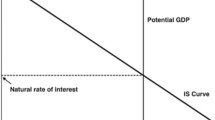Abstract
What have we learned from the recent international experiences with negative interest rates? This paper reviews the evidence. Negative interest rates have proved so unpopular that it is unlikely that a full liberation from the Zero Lower Bound is within sight. The Swiss experience, however, suggests it might be possible to adopt significantly lower interest rates by capitalizing on the unwillingness of banks to transmit negative rates to retail depositors while making it financially feasible for them to do so. The resulting asymmetric transmission mechanism may suit small open economies in need of a negative interest differential.



Source: SNB

Sources: Bech and Malkhozov (2016)/Bloomberg; national data


Source: SNB

Source: SNB

Source: SNB

Sources: Bech and Malkhozov (2016)/Bloomberg; national data

Similar content being viewed by others
Notes
Calculated with November 2014 as a reference period. The exemption is CHF 10 mios for banks not subject to minimum reserve requirements.
See Berg (2016) for more details. Note that an increase in bank fees has also been reported in Switzerland.
In its 2015 Annual Report, the SNB reports purchases of 86.1 bill. Euros.
References
Agarwal, R and Kimball, M. 2015: Breaking through the Zero Lower Bound. IMF Working Paper 15/224.
Ball, L, Gagnon, J, Honohan, P, Krogstrup, S and Slok, T. 2016: The liquidity trap: What to do about it? ICMB 18th Geneva Report, preliminary draft-May 2016.
Bernanke, B. 2016: What tools does the fed have left? Part 1: Negative interest rates. https://www.brookings.edu/blog/ben-bernanke/2016/03/18/what-tools-does-the-fed-have-left-part-1-negative-interest-rates/.
Bech, M and Malkhozov, A. 2016: How have central banks implemented negative policy rates? BIS Quarterly Review, March 2016.
Berg, J. 2016: Danish supervisory authority interview. In: Taux d’intérêt négatifs – Douze Regards. Paris: Institut Messine, janvier 2016.
Brupbacher, D. Negative interest rates: the Swiss experience. UBS Global Research, March 2016.
Buiter, WH. 2009: Negative nominal rates: Three ways to overcome the Zero-Lower-Bound. NBER Working Paper 15118.
Cecchetti, S and Schoenholtz, K. 2016: How low can they go? http://www.moneyandbanking.com/commentary/2016/2/28/how-low-can-they-go.
Grisse, C, Krogstrup, S and Schumacher, S. 2016: The response of long-term yields to negative interest rates. Working Paper (incomplete draft) – SNB, April 2016.
Rogoff, K. 2014: Costs and benefits to phasing out paper currency. In: NBER Macroeconomics Annual Conference, mimeo.
Author information
Authors and Affiliations
Corresponding author
Rights and permissions
About this article
Cite this article
Danthine, JP. The Interest Rate Unbound?. Comp Econ Stud 59, 129–148 (2017). https://doi.org/10.1057/s41294-017-0019-3
Published:
Issue Date:
DOI: https://doi.org/10.1057/s41294-017-0019-3




